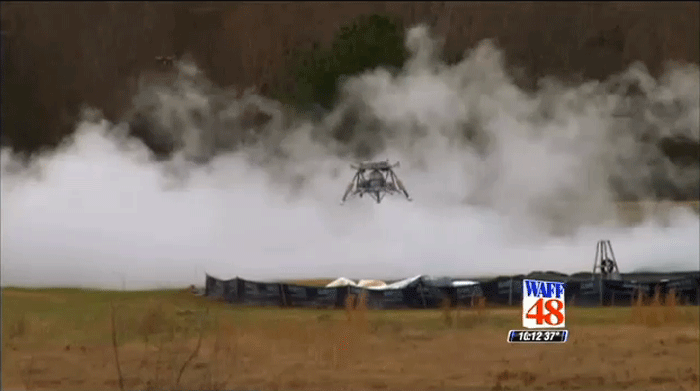.
Engineers with NASA and private space flight company Moon Express declared the latest flight of NASA's Mighty Eagle lander a success as it tested flight control software for MoonEx.
"During flight, it was very stable. It was, all in all, a great success," said Mighty Eagle Flight Manager Jason Adam.
The Eagle is meant to be a test platform for flight control and navigation systems for robotic spacecraft to land on the moon or other bodies such as asteroid. In a 20 second flight on Monday, the craft lifted off, hovered, and then landed safely, guided by software which Moon Ex plans eventually to use in unmanned lunar landing craft of its own.
"The hover time was a predicted," said MoonEx Vice President Michael D'Angelo. "The attitude stabilization of the vehicle was dead nuts on. It was solid as it hung there in flight. Under our control. So for us, it was a very important step in the ongoing development of our guidance navigation and control system."
Moon Express intends to carry payloads of cargo or instruments to the moon using a family of "workhorse" landing vehicles. In July, the company opened a Propulsion Development Facility in Huntsville.
"The capabilities to move payloads efficiently to and from the surface of the moon are approaching us," said D'Angelo. "I'd say within the next decade, we're going to be able to erect very significant infrastructure on the moon that could conceivably house human beings."
Quelle: WAFF
.

.

.

.

.

.

Frams: WAFF
.
Mighty Eagle – small lander – drew the attention of engineers today, though really, NASA wants to test the software inside.
NASA Project Manager Greg Chavers explains, “This test does determine if the software can control the vehicle.”
It starts to fire on all cylinders, the first sign that we’re close, but the whole test illustrates a big part of NASA’s new direction.
Chavers adds, “We’re in a partnership now with Moon Express, a US industry company, and we’ve loaded their software into our vehicle. And they will be controlling the vehicle today.”
All parties involved lean toward the edges of their seats.
NASA wants their partnerships to work; Moon Express wants their software to work.
Eventually, the vehicle hoists itself of the ground – a show of scientific force itself.
Chavers says, “There are sixteen thrusters, on the vehicle, and this software, we can show that it’s stable, completely autonomous, there’s no one operating it with a joystick.”
But it’s also a show of the power of private public partnerships like this one.
NASA leaders tell us Moon Express wants to compete for Google prizes for private space missions.
Quelle: WHNT
5740 Views
